Greenhouse gases trap heat in the Earth's atmosphere, leading to global warming and climate change. These gases include carbon dioxide, methane, nitrous oxide, and fluorinated gases, all contributing to increased temperatures and environmental disruptions. Explore the rest of this article to understand how your actions can reduce greenhouse gas emissions and protect the planet.
Table of Comparison
| Aspect | Greenhouse Gases | Microplastics |
|---|---|---|
| Definition | Gases trapping heat in Earth's atmosphere | Plastic particles smaller than 5mm |
| Main Types | CO2, Methane (CH4), Nitrous Oxide (N2O), Fluorinated gases | Fragments from larger plastics, fibers, beads |
| Primary Sources | Fossil fuel combustion, agriculture, deforestation | Plastic waste degradation, cosmetics, synthetic textiles |
| Environmental Impact | Global warming, climate change, ocean acidification | Marine toxicity, food chain contamination, ecosystem disruption |
| Persistence | Variable atmospheric lifespan (years to centuries) | Extremely durable, persisting decades to centuries |
| Mitigation Strategies | Emissions reduction, renewable energy, carbon capture | Plastic reduction, waste management, filtration technology |
Introduction to Greenhouse Gases and Microplastics
Greenhouse gases, such as carbon dioxide, methane, and nitrous oxide, trap heat in the Earth's atmosphere, driving global warming and climate change. Microplastics are tiny plastic particles less than 5 millimeters in diameter, originating from the breakdown of larger plastic waste and posing threats to marine ecosystems and human health. Both pollutants contribute to environmental degradation but differ significantly in sources, impacts, and management strategies.
Defining Greenhouse Gases: Sources and Impact
Greenhouse gases, including carbon dioxide (CO2), methane (CH4), and nitrous oxide (N2O), originate primarily from fossil fuel combustion, agriculture, and industrial processes, trapping heat in the Earth's atmosphere and driving global warming. These gases contribute to climate change by enhancing the natural greenhouse effect, leading to rising temperatures, melting ice caps, and increased frequency of extreme weather events. Unlike microplastics, which primarily cause physical pollution and harm marine ecosystems, greenhouse gases have a direct impact on atmospheric temperature and global climate systems.
Understanding Microplastics: Origins and Distribution
Microplastics originate primarily from the fragmentation of larger plastic debris and the shedding of synthetic fibers in textiles, entering marine and terrestrial ecosystems worldwide. These particles disperse through water currents, atmospheric deposition, and soil transport, accumulating in remote and urban environments alike. Understanding the widespread distribution and persistence of microplastics is crucial for assessing their environmental and health impacts in comparison to greenhouse gases.
The Role of Greenhouse Gases in Climate Change
Greenhouse gases, including carbon dioxide, methane, and nitrous oxide, trap heat in the Earth's atmosphere, leading to global warming and climate change. Their increased concentrations result from human activities such as fossil fuel combustion, deforestation, and agriculture, intensifying the greenhouse effect and disrupting climate patterns. Unlike microplastics, which primarily impact marine and terrestrial ecosystems, greenhouse gases directly influence global temperature rise and extreme weather events.
Microplastics and Their Effects on Ecosystems
Microplastics, minute plastic particles under 5mm in size, infiltrate marine and terrestrial ecosystems causing widespread ecological damage. These pollutants disrupt food chains by being ingested by aquatic organisms, leading to bioaccumulation of toxic substances and altering reproductive patterns. Unlike greenhouse gases that primarily affect atmospheric conditions, microplastics directly threaten biodiversity and the physiological health of wildlife across various habitats.
Global Health Concerns: Comparing Risks
Greenhouse gases primarily contribute to global warming, resulting in extreme weather events and respiratory issues from increased air pollution, posing widespread health risks. Microplastics infiltrate food chains and water supplies, leading to potential toxic exposure and inflammatory responses in humans, with emerging evidence linking them to chronic diseases. Both pollutants present critical challenges for global health, demanding urgent action to mitigate long-term environmental and physiological impacts.
Mitigation Strategies for Greenhouse Gas Emissions
Mitigation strategies for greenhouse gas emissions include transitioning to renewable energy sources such as solar, wind, and hydroelectric power, which significantly reduce carbon dioxide and methane output. Enhancing energy efficiency in transportation, industry, and buildings lowers fossil fuel consumption and associated emissions. Carbon capture and storage (CCS) technologies also play a critical role in capturing emitted greenhouse gases before they reach the atmosphere, supporting global climate targets.
Solutions to Microplastics Pollution
Microplastics pollution can be mitigated through advanced filtration technologies in wastewater treatment plants and promoting biodegradable alternatives to conventional plastics. Implementing stricter regulations on plastic production and improving waste management systems reduce microplastic release into aquatic environments. Public awareness campaigns and international cooperation are essential to fostering sustainable consumption and minimizing microplastic contamination globally.
Policy Approaches: Regulation and Enforcement
Effective policy approaches to greenhouse gases emphasize regulation through emissions standards, carbon pricing, and international agreements like the Paris Accord to enforce reductions and promote sustainability. Microplastic pollution policies focus on banning or restricting single-use plastics, improving waste management systems, and implementing product labeling to reduce environmental contamination. Enforcement mechanisms include monitoring compliance, imposing fines for violations, and incentivizing innovation in biodegradable alternatives to achieve measurable environmental benefits.
Future Outlook: Addressing Both Environmental Threats
Future outlooks for addressing greenhouse gases and microplastics emphasize innovative technologies such as carbon capture and biodegradable plastics development. Policy frameworks increasingly integrate climate action with marine pollution control to promote sustainable ecosystems. Advances in monitoring systems and global cooperation are critical for mitigating long-term impacts of both environmental threats.
Greenhouse gases Infographic

 libterm.com
libterm.com